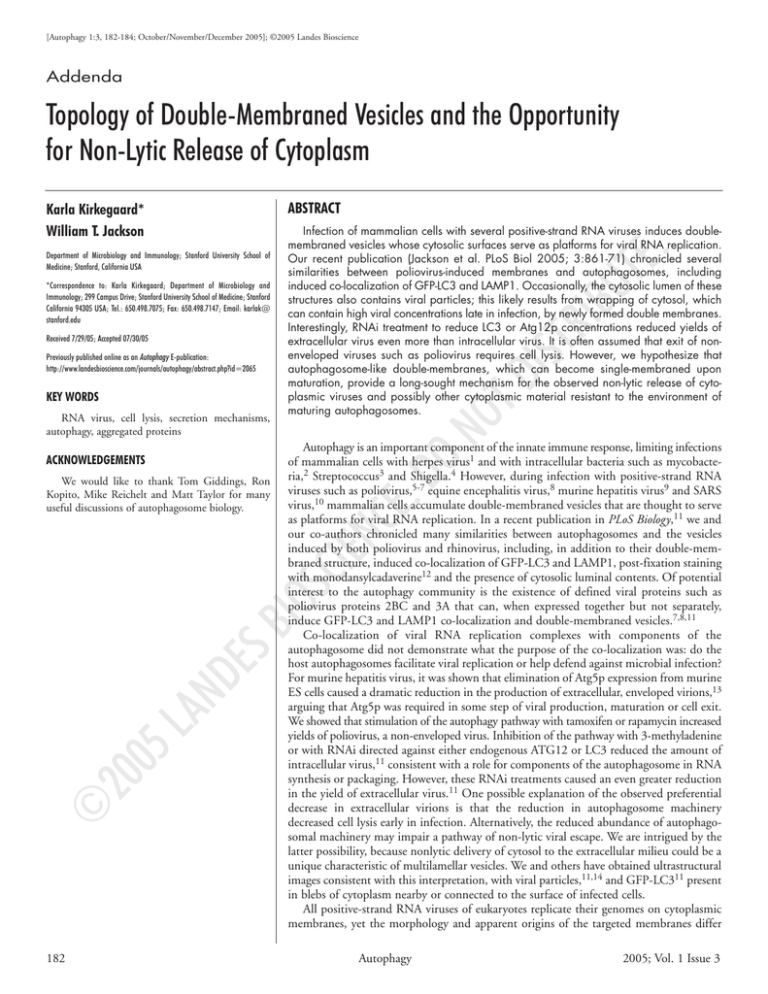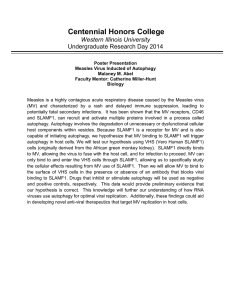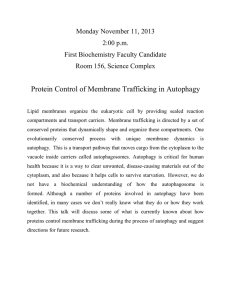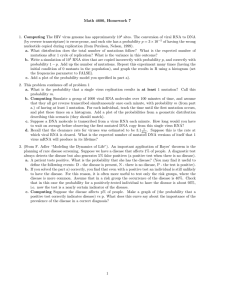Topology of Double-Membraned Vesicles and the Opportunity for
advertisement

[Autophagy 1:3, 182-184; October/November/December 2005]; ©2005 Landes Bioscience Topology of Double-Membraned Vesicles and the Opportunity for Non-Lytic Release of Cytoplasm Addenda ABSTRACT KEY WORDS RNA virus, cell lysis, secretion mechanisms, autophagy, aggregated proteins ACKNOWLEDGEMENTS . UT E RIB Autophagy is an important component of the innate immune response, limiting infections of mammalian cells with herpes virus1 and with intracellular bacteria such as mycobacteria,2 Streptococcus3 and Shigella.4 However, during infection with positive-strand RNA viruses such as poliovirus,5-7 equine encephalitis virus,8 murine hepatitis virus9 and SARS virus,10 mammalian cells accumulate double-membraned vesicles that are thought to serve as platforms for viral RNA replication. In a recent publication in PLoS Biology,11 we and our co-authors chronicled many similarities between autophagosomes and the vesicles induced by both poliovirus and rhinovirus, including, in addition to their double-membraned structure, induced co-localization of GFP-LC3 and LAMP1, post-fixation staining with monodansylcadaverine12 and the presence of cytosolic luminal contents. Of potential interest to the autophagy community is the existence of defined viral proteins such as poliovirus proteins 2BC and 3A that can, when expressed together but not separately, induce GFP-LC3 and LAMP1 co-localization and double-membraned vesicles.7,8,11 Co-localization of viral RNA replication complexes with components of the autophagosome did not demonstrate what the purpose of the co-localization was: do the host autophagosomes facilitate viral replication or help defend against microbial infection? For murine hepatitis virus, it was shown that elimination of Atg5p expression from murine ES cells caused a dramatic reduction in the production of extracellular, enveloped virions,13 arguing that Atg5p was required in some step of viral production, maturation or cell exit. We showed that stimulation of the autophagy pathway with tamoxifen or rapamycin increased yields of poliovirus, a non-enveloped virus. Inhibition of the pathway with 3-methyladenine or with RNAi directed against either endogenous ATG12 or LC3 reduced the amount of intracellular virus,11 consistent with a role for components of the autophagosome in RNA synthesis or packaging. However, these RNAi treatments caused an even greater reduction in the yield of extracellular virus.11 One possible explanation of the observed preferential decrease in extracellular virions is that the reduction in autophagosome machinery decreased cell lysis early in infection. Alternatively, the reduced abundance of autophagosomal machinery may impair a pathway of non-lytic viral escape. We are intrigued by the latter possibility, because nonlytic delivery of cytosol to the extracellular milieu could be a unique characteristic of multilamellar vesicles. We and others have obtained ultrastructural images consistent with this interpretation, with viral particles,11,14 and GFP-LC311 present in blebs of cytoplasm nearby or connected to the surface of infected cells. All positive-strand RNA viruses of eukaryotes replicate their genomes on cytoplasmic membranes, yet the morphology and apparent origins of the targeted membranes differ © 20 05 LA ND ES BIO SC IEN We would like to thank Tom Giddings, Ron Kopito, Mike Reichelt and Matt Taylor for many useful discussions of autophagosome biology. IST Previously published online as an Autophagy E-publication: http://www.landesbioscience.com/journals/autophagy/abstract.php?id=2065 OT D Received 7/29/05; Accepted 07/30/05 ON *Correspondence to: Karla Kirkegaard; Department of Microbiology and Immunology; 299 Campus Drive; Stanford University School of Medicine; Stanford California 94305 USA; Tel.: 650.498.7075; Fax: 650.498.7147; Email: karlak@ stanford.edu .D Department of Microbiology and Immunology; Stanford University School of Medicine; Stanford, California USA Infection of mammalian cells with several positive-strand RNA viruses induces doublemembraned vesicles whose cytosolic surfaces serve as platforms for viral RNA replication. Our recent publication (Jackson et al. PLoS Biol 2005; 3:861-71) chronicled several similarities between poliovirus-induced membranes and autophagosomes, including induced co-localization of GFP-LC3 and LAMP1. Occasionally, the cytosolic lumen of these structures also contains viral particles; this likely results from wrapping of cytosol, which can contain high viral concentrations late in infection, by newly formed double membranes. Interestingly, RNAi treatment to reduce LC3 or Atg12p concentrations reduced yields of extracellular virus even more than intracellular virus. It is often assumed that exit of nonenveloped viruses such as poliovirus requires cell lysis. However, we hypothesize that autophagosome-like double-membranes, which can become single-membraned upon maturation, provide a long-sought mechanism for the observed non-lytic release of cytoplasmic viruses and possibly other cytoplasmic material resistant to the environment of maturing autophagosomes. CE Karla Kirkegaard* William T. Jackson 182 Autophagy 2005; Vol. 1 Issue 3 Topology of Double-Membraned Vesicles and the Opportunity for Non-Lytic Release of Cytoplasm greatly from virus to virus. In a striking example, Flock House Virus, a nodavirus whose RNA replication cycle can be mimicked in S. cerevisiae, normally establishes RNA replication complexes on the outer mitochondrial membranes of infected cells.15 However, when Flock House Virus RNA replication complexes were retargeted to the endoplasmic reticulum (ER), the efficiency of viral RNA replication actually increased.16 These kinds of data suggest that different RNA viruses may co-opt different subcellular compartments for some reason other than the exigencies of replicating RNA, such as to alter cellular signal transduction in ways that are useful during infections of natural hosts. Why do poliovirus and rhinovirus induce the formation of autophagosome-like membranes on which to replicate their RNA? Perhaps the subversion of components of the autophagy pathway by poliovirus and rhinovirus inactivates the innate immune response that autophagy can provide. In addition, the decrease in extracellular virus upon RNAimediated reduction of LC3 or Atg12p suggests that the topology of double-membraned vesicles provides an answer to a long-standing puzzle in the biology of non-enveloped Figure 1. A potential role for double-membraned vesicles in non-lytic release of cytoplasm. viruses. Nominally lytic viruses are often assumed to spread Although poliovirus and other non-lytic viruses primarily exit cells via lysis, an alternative, exclusively via cell lysis. However, the possibility of non- non-lytic route of cell exit is consistent with many experimental observations.14,17-19 viral RNA replication, virions lytic release of poliovirus and other picornaviruses has been While the surface of these membranes is the known site of5,6,11 can be observed within the vesicle lumen late in infection. Extracellular cytoplasmic suggested from numerous reports of persistently infected blebs containing both virus and GFP-LC3 have also been observed.11,14 17,18,14,19 cell lines that continuously secrete infectious particles. Even more convincingly, when polarized Caco-2 cultures, growing as intact monolayers, were infected with poliovirus, newly sensitive as a viral plaque assay. This is, of course, one of the reasons synthesized virus was shown to emerge only from the apical sur- that viruses have so often identified novel mechanisms in cell biology, face.14 Assays showed that the monolayer remained intact, arguing and we speculate that the unique topology of a double-membraned that a non-lytic, and polarized, exit route of unknown origin had compartment, which can transform into a single-membraned been utilized. We speculate that this non-lytic exit route could be compartment to facilitate the direct release of cytosolic contents to provided by the unusual topology of organelles that begin as double- the extracellular milieu, may be one such mechanism. membraned vesicles with cytosolic contents in their lumen (Fig. 1). References Early in picornavirus infection, double-membraned structures 1. Talloczy Z, Jiang W, Virgin HWt, Leib DA, Scheuner D, Kaufman RJ, Eskelinen E-L, Levine B. Regulation of starvation- and virus-induced autophagy by the eIF2a kinase sigwould entrap cytosol, but this cytosol would be free of virions. naling pathway. Proc Natl Acad Sci USA 2002; 99:190-5. However, at later stages of infection, the cytosol trapped by newly 2. Gutierrez MG, Master SS, Singh SB, Taylor GA, Colombo MI, Deretic V. Autophagy is a generated double-membraned structures would often contain viral defense mechanism inhibiting BCG and Mycobacterium tuberculosis survivial in infected macrophage. Cell 2004; 119: 753-66. particles. Poliovirions and related enteroviruses are relatively resis3. Nakagawa I, Amano A, Mizushima N, Yamamoto A, Yamaguchi H, Kamimoto T, Nara A, tant to the low pH and active proteolysis that would prevail within Funao J, Nakata M, Tsuda K, Hamada S, Yoshimori T. Autophagy defends cells against the lumen of these vesicles, should they mature. Maturation of invading group A Streptococcus. Science 2004; 306:1037-40. 4. Ogawa M, Yoshimori T, Suzuki T, Sagara H, Mizushima N, Sasakawa C. Escape of intraautophagosomes results in the complete or partial degradation of the cellular Shigela from autophagy. Science 2005; 307:727-31. inner membrane: in this case, the fusion of the autophagosome with 5. Dales S, Eggers HJ, Tamm I, Palade GE. Electron microscopic study of the formation of the plasma membrane would then allow the release of formerly poliovirus. Virol 1965; 26:379-89. 6. Schlegel A, Giddings TH, Ladinsky MS, Kirkegaard K. Cellular origin and ultrastructure cytosolic material (Fig. 1). If the autophagosome-like structure of membranes induced during poliovirus infection. J Virol 1996; 70:6576-88. remains double-membraned, then fusion of the outer membrane 7. Suhy DA, Giddings TH Jr., Kirkegaard K. Remodeling the endoplasmic reticulum by with the plasma membrane would release packets of membranepoliovirus infection and by individual viral proteins: an autophagy-like origin for virusinduced vesicles. J Virol 2000; 74:8953-65. enclosed cytosol,11,14 which may or may not remain intact. 8. Snijder EJ, van Tol H, Roos N, Pedersen KW. Non-structural proteins 2 and 3 interact to The non-lytic release of cytosolic proteins is also a potential modify host cell membranes during the formation of the arterivirus replication complex. J explanation for the apparently non-lytic, cell-to-cell spread of aggreGen Virol 2001; 82:985-94. 9. Gosert R, Kanjanahaluethai A, Egger D, Bienz K, Baker SC. RNA replication of mouse gated protein conglomerates.20-22 It has long been known that hepatitis virus takes place at double-membrane vesicles. J Virol 2002; 76:3697-708. autophagosomal structures cluster around aggregated proteins in 10. Goldsmith CS, Tatti KM, Ksiazek TG, Rollin PE, Comer JA, Lee WW, Rota PA, Bankamp cells23,24 and recently a positive role for autophagy has been sugB, Bellini WJ, Zaki SR. Ultrastructural characterization of SARS coronavirus. Emerg Infect Dis 2004; 10:320-6. gested in clearance of aggregates of huntingtin,25,26 the protein that, 11. Jackson WT, Giddings TH Jr, Taylor MP, Mulinyawe S, Rabinovitch M, Kopito RR, when mutant, can cause Huntington’s disease. It is possible that the Kirkegaard K. Subversion of cellular autophagosomal machinery by RNA viruses. PLoS unique topology of double-membraned vesicles is involved in the Biol 2005; 3:861-71. non-lytic escape of other cytosolic constituents besides viruses. It 12. Biederbick A, Kern HF, Elsasser HP. Monodansylcadaverine (MDC) is a specific in vivo marker for autophagic vacuoles. Eur J Cell Biol 1995; 66:3-14. will be fascinating to determine the potential of the autophagy 13. Prentice E, Jerome WG, Yoshimori T, Mizushima N, Denison MR. Coronavirus replicapathway to provide a non-lytic release mechanism for a variety of tion complex formation utilizes components of cellular autophagy. J Biol Chem 2004; 279:10136-41. cytosolic constituents, although it will be difficult to devise assays as www.landesbioscience.com Autophagy 183 Topology of Double-Membraned Vesicles and the Opportunity for Non-Lytic Release of Cytoplasm 14. Tucker SP, Thornton CL, Wimmer E, Compans RW. Vectorial release of poliovirus from polarized human intestinal epithelial cells. J Virol 1993; 67:4274-82. 15. Miller DJ, Schwartz MD, Ahlquist P. Flock house virus RNA replicates on outer mitochondrial membranes in Drosophila cells. J Virol 2001; 75:11664-76. 16. Miller DJ, Schwartz MD, Dye BT, Ahlquist P. Engineered retargeting of viral RNA replication complexes to an alternative intracellular membrane. J Virol 2003; 77:12193-202. 17. Colbere-Garapin F, Christodoulou C, Crainic R, Pelletier I. Persistent poliovirus infection of human neuroblastoma cells. Proc Natl Acad Sci USA 1989; 86:7590-4. 18. Lloyd RE, Bovee M. Persistent infection of human erythroblastoid cells by poliovirus. Virol 1993; 194:200-9. 19. Zhang S, Racaniello VR. Persistent echovirus infection of mouse cells expressing the viral receptor VLA-2. Virol 1997; 235:293-301. 20. Fevrier B, Vilette D, Archer F, Loow D, Faigle W, Vidal M, Luaude H, Raposo G. Cells release prions in association with exosomes. Proc Natl Acad Sci USA 2004; 101:9683-8. 21. Prinz M, Heikenwalder M, Junt T, Schwarz P, Glatzel M, Heppner F, Fu Y-X, Lipp M, Aguzzi A. Positioning of follicular dendritic cells within the spleen controls prion neuroinvasion. Nature 2003; 425:957-62. 22. Schatzl HM, Laszlo L, Holtzman DM, Tatzelt J, Dearmond SJ, Weiner RI, Mobley WC, Prusiner SB. A hypothalamic neuronal cell line persistently infected wtih scrapie prions exhibits apoptosis. J Virol 1997; 71:8821-31. 23. Larson KE, Sulzer D. Autophagy in neurons: a review. Histol Histopathol 2002; 17:897-908. 24. Shintani T, Klionsky DJ. Autophagy in health and disease: a double-edged sword. Science 2004; 306:990-05. 25. Qin Z-H, Wang Y, Kegel KB, Kazantsev A, Apostol BL, Thompson LM, Yoder J, Aronin N, DiFiglia M. Autophagy regulates the processing of amino terminal huntingtin fragments. Human Molec Genet 2003; 12:2131-3244. 26. Ravikumar B, Vacher C, Berger Z, Davies JE, Luo S, Oroz LG, Scaravilli F, Easton DF, Duden R, O’Kane CJ, Rubinsztein DC. Inhibition of mTOR induces autophagy and reduces toxicity of polyglutamine expansions in fly and mouse models of Huntington disease. Nat Genet 2004; 36:585-95. 184 Autophagy 2005; Vol. 1 Issue 3




